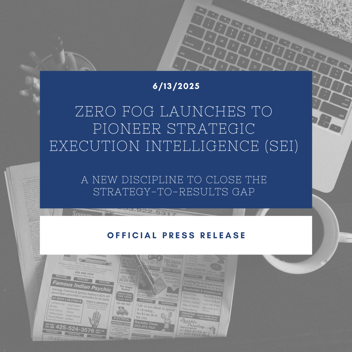Why Execution Fails (Even When the KPIs Look Fine)
Most organizations don’t fail because they lack data.
They fail because they misread execution signals hiding beneath the data.
On the surface, the dashboard looks good:
✅ KPIs are green
✅ Budgets are aligned
✅ Teams are reporting “progress”
Yet somehow…
❌ Results don’t scale
❌ Strategic momentum stalls
❌ No one can explain why things aren’t working
Welcome to the execution illusion.
⚠️ The KPI Illusions That Sabotage Strategy
Despite decades of investment in dashboards, OKRs, and planning tools, execution failure rates still sit between 60%–90% (McKinsey, HBR).
Why?
Because we confuse performance tracking with execution intelligence.
Let’s break down the 3 most dangerous illusions—and how high-performing teams engineer their way out of them.
🪞 1️⃣ “We See the Metrics, So We Understand the Business”
Reality: Most dashboards show outcomes—not causes.
Executives are flooded with charts. But when metrics dip or stall, dashboards don’t explain why.
There’s no visibility into:
- Execution maturity
- Process reliability
- Tech friction
- Talent effectiveness
💡 Case Study:
A global SaaS company I worked with had strong NRR—until one quarter, it plummeted. Nothing in the dashboard explained it.
The root cause?
- Post-launch onboarding delays
- Customer success leadership churn
- No visibility into those execution layers until after performance fell
✅ What elite teams do:
They build a Digital Mirror—layering execution diagnostics on top of KPI data to catch issues before they show up in results.
🎯 2️⃣ “We Assigned Owners, So Accountability Is Clear”
Reality: Most KPI ownership lacks causal control.
It’s easy to assign metrics to leaders. But who owns the levers behind the metric?
Example:
Sales conversion rate goes to the CRO…
But lead quality, pricing friction, and demo effectiveness live elsewhere.
💡 Netflix Example:
Netflix uses the Informed Captain model:
The person closest to the work owns the decision—even over execs.
This keeps execution moving fast and aligned.
✅ What elite teams do:
- Map causal drivers to KPIs
- Assign execution ownership, not just metrics
- Build cross-functional accountability loops
📊 3️⃣ “We’re Benchmarking Well, So We’re on Track”
Reality: Benchmarks mask decay.
Benchmarking against peers creates false confidence.
Success is defined by your own potential—not someone else’s average.
💡 PE Firm Insight:
Top PE firms track portfolio execution maturity, not just industry performance.
Why? Because value creation = closing your own execution gaps, not copying the market.
✅ What elite teams do:
- Blend benchmark data with maturity models
- Run gap-to-potential diagnostics
- Align execution goals with strategic ambition, not comfort
🧠 From KPI Reporting to Execution Intelligence
KPI tracking isn’t enough.
You need a system that answers:
✅ What’s driving the KPI?
✅ What’s missing in our execution systems?
✅ Where are we exposed—and how can we act faster?
Execution Intelligence = Strategy + Causality + Maturity + Monitoring
🔁 Reporting asks: “What happened?”
🔍 Intelligence asks: “Why—and what should we do next?”
|
📉 Traditional |
🚀 Execution Intelligence |
|
Lagging KPIs |
Causal early warning signals |
|
Metric owners |
Driver owners & maturity scores |
|
Industry averages |
Internal potential vs. ambition |
|
Monthly reviews |
Real-time execution visibility |
🔬 What It Looks Like in Practice
🧪 Healthcare system scenario:
- EBITDA target: +20%
- Revenue: flat
- Costs: rising
Dashboards show margin compression—but not why.
An execution diagnostic reveals:
- Staff inefficiency post-merger
- Missing outpatient cost data
- Level 2 maturity in workforce planning
- $32M in preventable leakage
The CFO now knows where to act, why it matters, and how fast to move.
🚀 Final Thought
Most organizations have data visibility.
Very few have execution visibility.
KPI dashboards tell you what happened.
Execution intelligence tells you why—and how to fix it.
If your KPIs look fine but progress feels off, it’s not a dashboard problem.
It’s a clarity problem.
And clarity is the first step to momentum.
👉 Coming next:
📌 “Execution Maturity Isn’t a Buzzword—It’s a Performance Multiplier”
How to assess execution maturity across strategy, tech, people, and process—and why it’s the missing link between good plans and great results.



